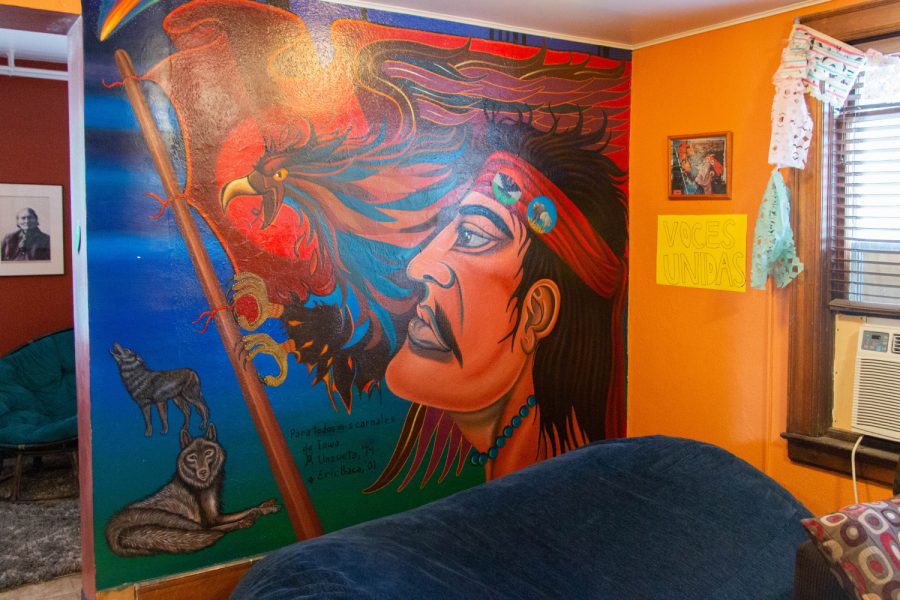Maintaining the momentum
April 20, 2021
A mural in the Latino Native American Cultural Center is seen at 308 Melrose Ave. in Iowa City, IA. The mural was restored in 2001, but lost its original colors and the original artist’s name. Established in 1971, the center celebrates its 50th anniversary this year.
As the years went on, the movement to bring more students of underrepresented identities to campus continued.
During a weekend event on Aug. 27, 1994, the original name of the center was changed to the Latino Native American Cultural Center (LNACC), reflecting the varied cultures, languages, or tribal affiliations of both cultures.
“They called me before the change,” Barceló said. “I just asked that the sign always says it was founded by Chicano and Meskwaki students.”
When Tracy Peterson, former UI College of Engineering diversity and outreach programs director and citizen of the Diné (Navajo) Nation, arrived at the UI in fall of 1993, he began to embrace the opportunities around him. He took part in different science programs and played rugby. He would also meet his wife during his time at the UI, all while engaging with the LNACC.
During his time, Tracy worked closely with the Native American Student Association, connecting with older students and students that came after him to maintain the sense of community, using the LNACC as a support space.
The DI reported in 1999 that students were concerned about a UI proposal to move the cultural centers to a combined location in the Iowa Memorial Union. Because of student opposition, however, the centers remained in their spaces on the west side of campus.
“The LNACC was the integral connection to facilitating our connection,” Tracy said. “It was a place we could go to disconnect from the larger campus.”
When he began master’s degree at the UI, Tracy was offered a manager position at the LNACC, with hopes to bring more professional development opportunities to the position. Meanwhile, his daughter, Adriana Nazhone Peterson, would accompany her parents to the LNACC for dinners and other events.
For Adriana, a citizen of both the Diné (Navajo) Nation and the Menominee tribe and a transfer student currently at Penn State University, the LNACC was one of the key reasons she attended the UI at the start of her undergraduate career in fall 2016. She recalls being one of the kids in the 90s and early 2000s running around the house with other children of students.
“This is a culture, and it will open its arms,” Adriana said. “It was a family environment … It’s a different type of environment.”
Adriana remembers the space quite differently from what it looks like today — she recalls old red couches that used to sit in the LNACC living room and how much she used to love to sit around with friends in that room.
“The red couches were a true experience to take a nap on,” Adriana said, laughing.
In fall 2019, Adriana, Tracy, and her mother Nicole would move out to Penn State University.
Ttakimaweakwe Keely Driscoll, a member of the Meskwaki (wolf clan) with ties to the Winnebago tribe of Nebraska (Ho-chunk), was also one of the LNACC children who could remember Thursdays in the house while her mother was getting her master’s degree through the UI. Driscoll is the current president of the Native American Student Association and a third-year student at the UI.
She remembers some of her first Powwow experiences and witnessing firsthand the organization and feelings of togetherness.
“I felt this was an event that valued and honored the culture,” Driscoll said.
The UI Powwow, founded in 1990, highlighted beautiful dances of Native American culture and different traditions. It was a time for celebration and honoring Native American identities and tradition. The UI Powwow has hosted more than 350 dancers, 18 drum groups, and 60 arts and crafts vendors.
According to the Powwow website, the Chicano Indian American Student Union held smaller gatherings where Native American dance was one of many symposium topics. In fall 1989, the American Indian Student Association was founded by Orrenzo Snyder (Diné), Larry Lasley (Meskwaki), Alex Walker (Meskwaki), Judy Morrison (Osage), and Stephanie Griffith (Dakota), all of whom are now UI alumni.
By fall 2013, students decided to change the name to Native American Student Association (NASA) to better fit with the changing times.
A land acknowledgment was also created in October 2020 to show respect toward Indigenous peoples and recognize that the UI is located on the homelands of tribal nations. It was formed as an expression of gratitude by the UI Native American Council and is supported by many at the UI.
The centers and their programs have been funded through various channels including General Education Funds, the Student Activity Fee, and other external sources to continue to improve the centers. In fiscal years 2016 and 2017, UI President Bruce Harreld approved central funds of $200,000 to go towards renovations and upgrades in the centers. An additional $50,000 was allocated in fiscal year 2018 to finish the projects. Also, the centers have received $40,000 from the Student Activity Fee for the past three fiscal years, along with the ongoing general education funds the centers receive. In fiscal years 2022-2024, pending state Board of Regents approval, the centers will receive $45,000 each year from the Student Activity Fee. These figures do not include the General Education Funds that are allocated for the salaries and fringe benefits of the professional and scientific center staff.
